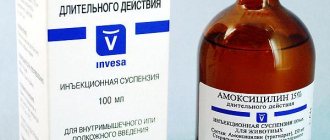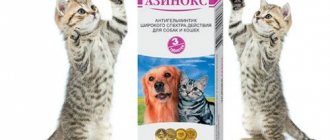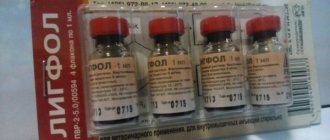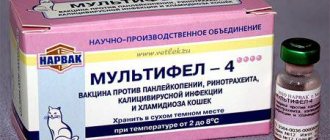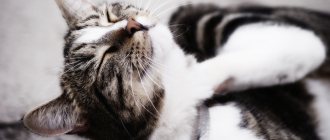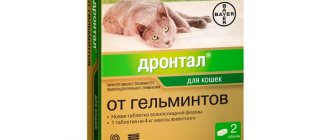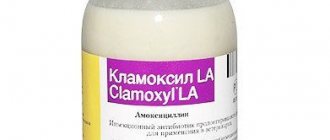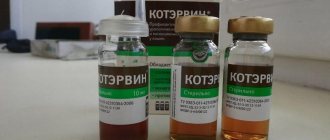Composition and release form
Amoxicillin is a semi-synthetic antibacterial drug from the group of penicillin antibiotics, which is manufactured in the Spanish province in the form of powder, tablets or capsules, and injection suspensions.
Amoxicillin for cats
The composition of the drug, depending on the form of release, is presented in the table.
| Component | Suspension for injection | Powder | Pills |
| Amoxicillin trihydrate | 150 mg/ml | 10% | 250 mg/piece |
| Auxiliary components | Whitish oily liquid | Can be diluted with water | Lactose, magnesium stearate, silicon dioxide |
| Package | Dark glass bottles of 10, 100, 250 ml | Paper, metallized bags, plastic cups weighing from 0.05 to 25 kg | 10 pcs in a plastic blister, 24 pcs in a glass jar |
Amoxicillin for cats - release forms
The most convenient form is suspensions, the use of which minimizes the risk of erroneous calculation or overdose, which can lead to side effects.
Injection administration is characterized by a more gentle effect on the animal’s body; the therapeutic effect with such treatment occurs faster. But not every pet is able to patiently endure an injection, which is why tablets are chosen for home treatment.
In clinical settings, veterinarians prefer injections with an aqueous solution of powder, the administration of which is less painful compared to a dense oily liquid suspension.
Allergic reactions
These are the most common side effects to be aware of. After the bacteria die, all this biological mass will be excreted from the body through the kidneys and liver. In some cases, this phenomenon can cause the awakening of chronic diseases
That is, it is extremely important that the dosage of antibiotics is calculated individually, focusing on the age, weight and condition of the animal. In addition, it is necessary to use hepaprotectors and drugs that could relieve the load on the kidneys and liver
Individual intolerance is another problem that you may encounter if you use antibiotics. In this case, complete withdrawal or replacement of the drug with a more gentle one is necessary. Allergic reactions may cause swelling, itching, baldness and skin rashes. In the most severe cases, you may experience difficulty breathing and anaphylactic shock. That is, in any case, the choice of drug, its dosage and course duration should be determined by the doctor.
Analogs
Kanikvantel for cats: instructions for use
Amoxicillin has more than a dozen penicillin analogues. To treat bacterial diseases, the veterinarian, at his discretion, may prescribe:
- Amoxiclav suspension, the distinctive property of which is a longer action inside the cat’s body.
- Amoxil in tablet form, characterized by good digestibility and action within 3 hours after administration.
- Amoxican in suspensions.
- Bactoclav in the form of tablets and injection suspensions.
Amoxicillin analogue - Amoxiclav
Which cat is the drug contraindicated?
Sometimes Amoxicillin (for cats) may be contraindicated. In which cases? If the kitty has hypersensitivity to the main active substance or, in general, to any other penicillin antibiotics.
Important!
It is extremely undesirable to use the drug during lactation, since it is also excreted through milk. The only exception is if the owners seek to cure mastitis in their cat while feeding the kittens.
Pharmacology
Drontal for cats: instructions for use
Amoxicillin trihydrate has a pronounced bactericidal effect. Once the antibiotic enters the body of an infected pet, it begins to block the production of mucopeptide, a substance in cell walls. Simultaneously with the blocking, the substances of the drug have a destructive effect on the work of enzymes inside the bacterium, provoking the process of cellular destruction.
The medicine begins to act in about an hour and a half, as soon as it enters the bloodstream and spreads through the internal organs, persists for 48 hours and is excreted along with urine.
The wide spectrum of action of Amoxicillin allows you to effectively combat pathogenic microflora, the causative agents of which are:
- entero-, statilo- and streptococci;
- leptosyr;
- salmonella;
- protea;
- coli;
- listeria;
- clostridia.
Effect of the drug
This is an antibiotic whose action is based on inhibition of the formation of the cell wall of the microorganism. This disrupts the entire metabolism of the pathogenic element and leads to its death. "Amoxicillin" for cats is well absorbed and easily distributed throughout the body. Maximum concentration in muscles, kidneys and liver.
Any drug has its own duration of persistence in the blood. Due to the oil filler, Amoxicillin for cats slowly releases the active component and acts on pathogenic microflora for a long time. After just two hours, the content of the active substance in the blood becomes sufficient to fight bacteria. The therapeutic effect lasts up to 48 hours.
Indications for use
Cantaren for cats: instructions for use
Amoxicillin trihydrate is prescribed for the treatment of bacterial diseases such as cystitis, pneumonia, mastitis, vaginitis, salmonellosis, diarrhea, and abscess. It is used for inflammation of soft tissues and other infectious diseases caused by microorganisms sensitive to the action of antibiotics.
Veterinarians often prescribe this antibiotic for prophylactic purposes to reduce the risk of inflammation in cats after surgery. In this case, the use of the medicine is considered completely acceptable, and the benefits outweigh the possible harm. But the dose must be calculated by a specialist.
Using medication to treat pregnant cats
In fact, the pregnancy period involves stopping most medications. This applies to both humans and cats. However, if you ask the question of whether it is possible to inject Amoxicillin into pregnant cats, you can answer it as follows. If there are serious concerns for the life and health of the expectant mother, the doctor has to sacrifice possible consequences for the development of the fetus. In this case, the use of Amoxicillin for pregnant cats is completely justified. If there is an opportunity to avoid prescribing antibiotics, the doctor will definitely take advantage of it.
Amoxicillin injections: instructions for use for cats
The injection suspension is injected under the skin of the withers or intramuscularly into the thigh at the rate of 0.1 ml per 1 kg of weight.
Administration of Amoxicillin intramuscularly to a cat
Before use, the antibiotic bottle is thoroughly shaken until smooth. To ease the painful injection and spread more quickly through the bloodstream, it is recommended to massage the injection area before and after the procedure.
Attention! Inexperienced pet owners should check with their veterinarian on how to inject their cat with the antibiotic Amoxicillin, so as not to accidentally cause harm.
Repeated injections are administered no earlier than 48 hours after the first due to the long-term effect of the drug in this form. If complications of a severe bacterial disease are detected, inpatient treatment is prescribed, during which injections are allowed up to 4-5 times a day, with injections being given in different parts of the body. The duration of hospital treatment depends on the form and stage of the disease.
Amoxicillin from Biovet
The Czech-made drug is used in the treatment of diseases of large and small horned animals, pigs, and dogs. Before use, shake the bottle and mix thoroughly. Amoxicillin 15 is administered with a dry syringe 10 cm3/100 kg. A second injection is allowed two days later. Side effects are observed with individual hypersensitivity.
https://youtube.com/watch?v=DDXlfNOuFag
https://youtube.com/watch?v=DDXlfNOuFag
You cannot inject >20 cm3 into one point. The injection site should be thoroughly massaged. If the cow weighs 600 kg, injections should be given at three points.
Sometimes swelling is recorded, which disappears spontaneously 1–2 days after the injection. When identifying signs of personal hypersensitivity, desensitizing agents are used - corticosteroids.
Restrictions
The waiting time for slaughtering cattle is 5 weeks, pigs - 4, milk for food use - 4 days. The previously obtained milk is boiled and fed to animals.
Storage
In proper conditions, in original packaging, at a temperature of 15–25 ° C, the medicine is stored for 24 months. After the first sampling of the contents, the bottle is suitable for use for 28 days.
Amoxicillin for cats in tablet form
The dosage of the tablet is calculated in the proportion of 12.5 mg of active substance per 1 kg of cat’s weight:
- for individuals weighing up to 2.5 kg, a quarter of a tablet with a dosage of 250 mg/piece is sufficient;
- individuals weighing 3.0 - 5.0 kg are prescribed half a tablet;
- cats 5.0 - 7.5 kg three quarters of a tablet;
- cats weighing more than 8.0 kg are prescribed 1 tablet.
Amoxicillin for cats in tablets on a blister 10 pcs.
The tableted antibiotic is given to the pet once a day during or after meals for at least 5 days.
It is recommended to dissolve the crushed tablet in water and pour it down the cat’s throat using a pipette or syringe without a needle, or mix it with cat food.
Important! Please note that only a veterinarian can prescribe Amoxicillin to a kitten and select a dosage that is safe for a small animal. In this case, the specialist must conduct an examination and assess the physical condition of the pet.
What side effects may occur?
In some cases, it is impossible to do without antibiotics, but despite the fact that they effectively cope with infections, these substances have a detrimental effect on the cat’s body.
Regardless of what antibiotics are given to cats and in what form, we can definitely say that the beneficial microorganisms in the intestines will initially be destroyed. Consequently, the veterinarian will prescribe the necessary medications to restore normal functioning of the intestinal flora.
Cats may experience complications such as itching.
After exposure to antibiotics begins, harmful substances are removed from the body with the help of the kidneys and liver, and this can provoke an exacerbation of existing chronic diseases. Therefore, before treatment, you should definitely examine your pet, and based on the results, the specialist will be able to correctly determine the required dosage, which will help reduce the load on the organs. If necessary, use agents that cleanse the kidneys of harmful substances (hepatoprotectors) after completing a course of antibiotics.
In both humans and cats, complications in the form of allergic reactions often occur, so at the slightest sign you should take the animal to a veterinary clinic for examination and replacement of the drug or its complete withdrawal. Symptoms include swelling, itching, hair loss and skin rashes.
The most severe manifestation of allergies is anaphylactic shock. Antibiotics can also cause allergies to any food, detergents, etc.
Antibiotics can cause allergies to any food
If a cat is intolerant to a certain antibiotic, diarrhea or vomiting may occur, in which case the drug is replaced or the prescribed dosage is reduced.
Powder
A 10% concentrate is diluted in a small amount of water and poured down the cat’s throat or mixed with food. When Amoxicillin is given to a cat, the dosage is calculated in the ratio of 0.5 g per 2.5 kg of animal weight. To accurately calculate the dosage, it is recommended to use a measuring spoon.
Dosage regimen: 1 time per day for 5-7 days.
Veterinary antibacterial powder Amoxicillin 10%
general description
Most often, an antibiotic is used for dogs in the form of a suspension intended for intramuscular or subcutaneous injection. The outwardly white liquid is packaged in glass bottles, which are sealed with rubber stoppers and rolled up with aluminum lids to maintain tightness. The composition of the drug is based on amoxicillin in the form of trihydrate. Its concentration in the drug is 150 mg per 1 ml of suspension. It also contains an oily filler. It performs a special role - it ensures the long-term effect of the main component.
Note! You can store the medicine in an opened bottle for no more than 28 days. The antibacterial agent is also available in the following pharmacological forms:
The antibacterial agent is also available in the following pharmacological forms:
- Pills. May contain 0.25 and 0.5 g of active ingredient. The tablets are resistant to gastric juice and are quickly absorbed from the gastrointestinal tract.
- Powder for oral administration. The concentration of the active substance is 150 mg of amoxicillin per gram of powder. Packaged in polymer bags of various volumes - from 1 g to 1 kg.
The main active substance amoxicillin is a semisynthetic antibiotic of the penicillin series. Its main advantage is its wide spectrum of action. The drug is active against various gram-positive and gram-negative bacteria. These include:
- streptococci;
- staphylococci;
- salmonella;
- enterobacter;
- pseudomonas;
- erysipeloids;
- pasteurella;
- listeria, etc.
A complete list of bacteria against which Amoxicillin is effective when used in dogs can be read in the instructions included with the medication.
Contraindications and side effects
If you follow the veterinarian's instructions and the exact dosage, Amoxicillin has no side effects. Allergic reactions are possible, if detected, it is strongly recommended to consult a veterinary clinic to change the drug.
Important! The drug is strictly contraindicated for animals with penicillin intolerance, renal impairment, liver and kidney failure.
Use with caution for the treatment of pregnant, lactating individuals, small kittens and only as prescribed by a veterinarian. Among antibiotics for animals, Amoxicillin is considered to be the most gentle and safe, but if the dosage is exceeded, pathologies of future offspring are still possible.
A slight swelling may occur at the injection site, which will subside on its own after a day or two. To minimize swelling from Amoxicillin injections for cats, light muscle massage before and after administration of the suspension allows you to minimize swelling.
Quite rarely, vomiting, diarrhea, cardiac dysfunction, impaired coordination of movements, and loss of space occur.
Like all antibiotics, Amoxicillin can cause dysbiosis and gastrointestinal upset. Therefore, the veterinarian, in combination with antibiotics, prescribes probiotics and the addition of fermented milk products to the diet. If signs of decreased immunity are detected, a specialist will prescribe a course of immunomodulators and vitamins.
Attention! It is prohibited to take Amoxicillin in combination with antibacterial and antimicrobial drugs.
Possibility of overdose and danger of taking the drug not on the advice of a veterinarian
This again depends on what form the medicine is taken in.
If the injections are for intramuscular administration, then the likelihood that the cat will receive an “overdose” of the medicine is extremely small.
By the way, after administering the injection, you need to lightly massage the injection site. That is, both before and after administration. If in powder, then, in principle, too. The dose is easy to calculate.
But if you use it in tablets, an overdose is very likely. Because it is extremely difficult to calculate the weight of the tablet and correlate it with the weight of the animal.
It should be recalled that the proportion of antibiotic in tablet form is 12.5 milligrams per 1 kilogram of kitty weight. And if the weight of the animal is small, for example, we are talking about a kitten, choosing the correct dosage of the medicine is very difficult, so it is better for the owner to use solutions or injections.
There is no need to self-medicate your cat; it is even strictly prohibited, since any antibiotic, including the one in question, has its own side effects. The most common manifestation is allergies. The place where the injection was administered may well become swollen, red, and conjunctivitis may begin to develop.
If the situation is more severe, allergies may develop. If there is a hint of these reactions, the drug should be discontinued without delay.
Side effects include vomiting (possible), very severe diarrhea, and the cat’s taste preferences may change dramatically.
Rarely, but still there have been cases of even ulcerative stomatitis due to the fact that the cat took this medicine. The animal's behavior may also change. He may have a slow reaction or overly excited behavior.
Taking the drug in form can lead to sensations of pain at the site of drug administration, and the cat begins to walk with a limp. Difficulty breathing and hoarseness can be observed in a number of animals. Long-term and unnecessary use (i.e., without the knowledge of the veterinarian) of an antibiotic can give rise to the development of fungi in the mouth and even diseases of the genital organs.
reviews
Vaska had terrible diarrhea for several days. After 3 days of his torment, I took the animal to the veterinarian. The result was dysentery. The doctor recommended Amoxicillin. I gave the powder for four days. Over time, the cat began to eat normally and gradually recovered. He tolerated the medicine quite well. No additional medications were needed.
After the kittens were born, we decided to wean them off the cat's breast early. As a result, mastitis developed. They thought that everything would go away on its own, but it was obvious how much pain she was in, so they brought her to the vet. To prevent complications, the veterinarian injected her with Amoxicillin for cats. Two days later, the administration of the drug was repeated. Three days later, the cat became healthy and cheerful, began to eat normally, and the mastitis disappeared. Thanks doctor!
How to give a cat a suspension video
When to use Amoxicillin
Diseases for which Amoxicillin for cats is used:
- problems associated with disorders in the gastrointestinal tract: enterocolitis;
- gastroenteritis;
- enteritis;
- bronchitis;
- pyelonephritis;
Mastitis in cats (acute inflammatory disease of the mammary gland) is one of the indications for the use of Amoxicillin
This medicine is also used for prophylactic purposes after surgery to prevent the possible occurrence of an inflammatory process.
How and where to inject amoxicillin in the form of an injection suspension?
It is important not only in what quantity, but also where the suspension is introduced. The injection should be given to the pet into a muscle or under the skin. According to the instructions, you cannot inject the drug into a vein. It is better to carry out this procedure in a veterinary clinic. Its employees are sufficiently qualified to give the four-legged patient an injection correctly and without any consequences to the health. The medicine can be injected into any muscle, but it is better into the thigh of the hind limb. When the drug is injected into this place, it is absorbed and absorbed most quickly.
If you have the skills to inject medications, you can give your pet an injection yourself. Before use, the bottle of suspension should be shaken well.
The drug is administered once. If necessary, your pet can be given a second injection after 48 hours. In severe cases of the disease, the number of procedures can be increased to 3–5. If repeated use of the medicine is necessary, it should be administered in different places.
Application and dosage
Regardless of the release form, the Amoxicillin package contains instructions for use for animals. To achieve maximum effect from therapy, it is recommended to read the advice of each manufacturer.
General rules for choosing a dosage: the body weight of the animal is multiplied by 15 mg of amoxicillin. In the liquid form, 1 ml of solution is taken for every 10 kg of weight.
For animals with signs of kidney or liver disease and small animals (less than 5 kg), careful dosage calculation is required.
For farm animals
Tablet and powder forms are not recommended (due to their greater weight than dogs, it becomes necessary to feed the pet too much medicine, which is inconvenient for animals).
The drug is administered by first drawing it into a disposable syringe. Before manipulation, it is recommended to shake the bottle for 5-10 seconds (to evenly distribute suspension particles in the oil filler).
In cows and pigs, the antibiotic is administered intramuscularly using the muscles in the leg in the femoral area. If there are pustular elements in this area, subcutaneous administration is allowed (gathering the skin on the animal’s neck into a fold). The total volume of the injected solution should be no more than 20 ml; to administer a larger volume, it is necessary to use different sides and areas of the body.
For dogs and cats
An antibiotic solution is drawn up with a dry syringe and injected intramuscularly or subcutaneously. After the injection, it is recommended to massage the injection site for better absorption of the drug.
The tablets are placed on the root of the pet’s tongue, the mouth is closed and, holding it, allowed to be swallowed. To help the animal swallow the tablet, you can gently stroke its throat.
To administer food solutions, use a syringe without a needle to pour the drug behind the lip.
